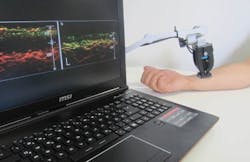Handheld optoacoustic scanner reveals vascularization in psoriasis patients
A team of researchers from Helmholtz Zentrum München and the Technical University of Munich (TUM; both in Munich, Germany) has developed a tissue scanner that allows clinicians to look underneath the skin of psoriasis (an inflammatory skin disease) patients. This provides clinically relevant information, such as the structure of skin layers and blood vessels, without the need for contrast agents or radiation exposure.
Related: Optoacoustic device project aims to transform skin cancer diagnosis
Currently, physicians evaluate the severity of psoriasis based on visual assessment of features of the skin surface, such as redness or thickness of the flaking skin. "Unfortunately, these standards miss all parameters that lie below the surface of the skin, and may be subjective," explains Juan Aguirre, group leader at the Institute of Biological and Medical Imaging (IBMI) at Helmholtz Zentrum München. "Knowing the structure of the skin and vessels before treatment can provide the physician with useful information," he adds.
To provide clinicians with this information, Aguirre and his team used a technique called raster-scan optoacoustic mesoscopy (RSOM), where a weak laser pulse excites the tissue of interest, which absorbs energy and heats up minimally. This causes momentary tissue expansion, which generates ultrasound waves. The scientists measure these ultrasound signals and use this information to reconstruct a high-resolution image of what lies under the skin.
While developing the method, the scientists were able to reduce the size of the scanner to a handheld device. "This technology, which is easy to use and does not involve any radiation exposure or contrast agent, is allowing us to acquire the first new insights into the disease mechanisms. It also facilitates treatment decisions for the physicians," explains Prof. Dr. Vasilis Ntziachristos, director of the IBMI at Helmholtz Zentrum München and Chair of Biological Imaging at TUM.
In a recently published study, the scientists demonstrated RSOM's performance by examining cutaneous and subcutaneous tissue from psoriasis patients. RSOM allowed them to determine several characteristics of psoriasis and inflammation, including skin thickness, capillary density, number of vessels, and total blood volume in the skin. They compiled these to define a novel clinical index (a value that includes several diagnostic parameters, allowing estimatation of the severity of a disease) for assessing psoriasis severity that may be superior to the current clinical standard because the new index also takes into account characteristics below the skin surface.
The researchers plan to use the same imaging method to assess other diseases such as skin cancer or diabetes in the future. Patients with diabetes often suffer from damaged blood vessels that, if detected early enough, may allow earlier treatment and therefore greater efficacy.
Full details of the work appear in the journal Nature Biomedical Engineering; for more information, please visit http://dx.doi.org/10.1038/s41551-017-0068.
